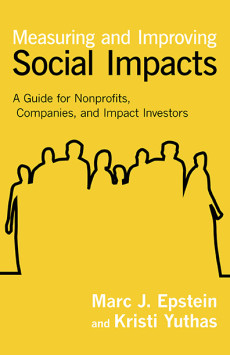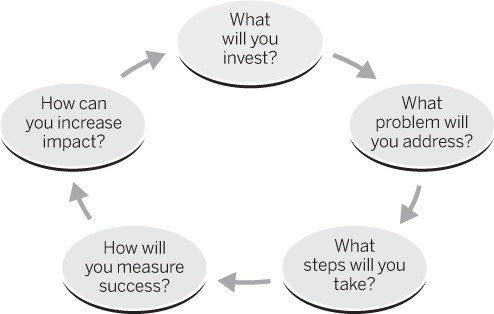
Measuring and Improving Social Impacts: A Guide for Nonprofits, Companies, and Impact Investors
Marc J. Epstein & Kristi Yuthas
256 pages, Berrett-Koehler Publishers, 2014
You’re investing your money, your time, your reputation in worthwhile causes, but are you really making a difference? Organizations talk a lot about the work they do and number of lives affected, but are these people really better off? The pressure to answer these questions has never been greater, yet the confusing array of metrics and tools make it hard to get meaningful, actionable information.
To address the problem head on, we interviewed measurement experts at more than 50 leading foundations, nonprofits, and social enterprises. The secrets we uncovered are summarized in a five-step process that will help gain clarity about the impacts that matter most to you and will provide you with a roadmap for measuring and improving them.
The following is an excerpt from the book.
Creating and Measuring Social Impact
This book is organized around the Social Impact Creation Cycle shown in Figure 1. The cycle is built around five questions:
- What will you invest?
- What problem will you address?
- What steps will you take?
- How will you measure success?
- How can you increase impact?
These questions are at the heart of promoting, funding, and managing organizations for maximizing social impact. The cycle applies to funders, whether they are individuals, governments, foundations, corporations, or investors. It similarly applies to operating organizations that provide services or support to or advocate for beneficiaries. Donors and investors focus on how their resources—human, material, and financial—can be best used to produce social impact and which problems should be priorities, while NGO managers and other service providers focus on how to address the social problems they face and how to maximize social impacts. For-profit companies need to focus on identifying and managing the impacts they create for their customers and other stakeholders affected by their actions. But all of these concerns are important enough to be explored by anyone interested in social impacts and the processes through which they are created.
Each group can also benefit from better understanding the interests and challenges of the others. Investors can do a better job when they understand the interests and operations of the organizations in which they invest, and operators can do a better job when they understand the needs and interests of those who fund them.

Figure 1: The Social Impact Creation Cycle.
Some of these topics are rarely discussed, such as the resources and interests of the investor, or why impact measures can’t be separated from the values of the individuals and organizations that use them. Also widely recognized but rarely measured are impacts created through sharing best practices and innovations or collaborating on goals. We devote extensive discussion here to those topics that are essential for effective decisions and have typically not been carefully articulated.
Step 1: What will you invest? In this step, you’ll first think about your investment goals. Why are you investing? What do you hope to accomplish through your investment? Do you expect social returns alone, or do you want financial returns as well? Do you have other goals, such as strengthening relationships, building your brand, or reciprocating for benefits you have received? You’ll also consider what resources you are willing to invest in social change—your time, your money, your expertise, your network.
Step 2: What problem will you address? Next, you’ll decide what kinds of problems you are interested in addressing, and whether you will focus on one issue or a portfolio of issues. You will consider which social and environmental causes are most important to you and how you can best serve beneficiaries using the resources you plan to invest. And you’ll consider the intervention approaches you wish to support, such as research, services, advocacy, or ecosystem support. You’ll decide what types of organizations you’re interested in—social enterprises, nonprofits, corporations—as well as how you’ll structure your investment in that organization, whether as venture capital, equity, a loan, or a gift. You’ll also decide what role you want to play in the organizations in which you invest. Do you prefer to be an outside observer, or do you want to be engaged directly in operations or governance?
Step 3: What steps will you take? Once you have identified your causes, you’ll plan for achieving the desired change. Social impacts flow from an organization’s mission and culture and can be created by the goods and services offered, by operations, and from passive investments. You’ll consider the various ways you’ll make an impact through your investments. For desired social impacts you’ll develop a theory about which actions can create those impacts, and then generate a logic model or results chain that can show exactly how the organization’s actions and outputs are expected to result in positive impacts for stakeholders and the environment. Finally, you’ll map out your stakeholders and the effects your organization will have on them, taking particular care to ensure that the interventions you plan are both beneficial to and desired by beneficiaries.
Step 4: How will you measure success? Performance measurement and management systems help you monitor how investments are creating social change. In this stage, you’ll consider the purpose of your measurement. Is it to learn how effective your work has been, to communicate expectations, or to satisfy investors’ accountability demands? You’ll also determine the kinds of measurement approaches that can provide the evidence you seek, whether investigation, analytics, and/or experiments. And you’ll make plans for developing a performance measurement system for gathering, analyzing, and using your performance data.
Step 5: How can you increase impact? In this step, you’ll evaluate the dimensions of your performance measurement system—the metrics collected, the purpose served, and their relationships with your strategy—with the goal of improving your system to increase your impacts. Finally, you’ll consider strategies for growing your organization and its impact. These can include sources of innovation, ingredients needed for successful scaling, and opportunities for collaborating and sharing your capabilities in order to leverage your impact beyond your own organization.
Each element in the Social Impact Creation Cycle in Figure 1 is connected by an arrow, and an arrow connects its last and first elements. The arrows suggest that working through the steps in the cycle is not a one-time process and that you’ll return to each question as you repeat the cycle to modify your actions and improve your performance.
The Need for Accountability
Governments are finding it difficult to provide the necessary resources to address social and environmental issues, and the burden is increasingly borne by nongovernmental service organizations, foundations, impact investors, and companies. Those donating to or investing in these organizations are reasonably asking for more accountability for the invested resources—as are beneficiaries and communities that have significant unmet needs. Further, when governments provide tax benefits for these investments, it is reasonable to demand that the money be wisely invested to create as much social impact as possible.
One of the most important activities in which any foundation, NGO, or impact investor can engage is to think through and articulate what achievements are desired and how they can realistically be achieved. A common explanation for lack of effectiveness is that the organization has not been clear enough about its definition of success and lacks a well-defined logic model that would likely lead to that success. Too often we find serious gaps in the logic model and little evidence that activities are likely to lead to the proposed impacts. These logic models need to be supported by empirical evidence, a clear logic, or both. But often they are supported by neither. As you’ll see, the Social Impact Creation Cycle helps bring clarity to logic models and thus enhances organizational accountability.
The Impact Measurement Roadmap
Although measuring and increasing social impact are commonly understood to be important, many become mystified by the process of implementing an impact measurement system. Even if you are effectively measuring and managing your impacts now, there are methods to increase your impacts that you might have overlooked. Working through the stages of the impact measurement road map can help you identify these methods and maximize your impacts.

Figure 2: The Impact Measurement Roadmap.
Measuring impacts can be a difficult process and requires careful planning. The Impact Measurement Roadmap, summarized in Figure 2 and discussed in depth in chapter 9, has four steps. In the first step, you’ll prepare the measurement foundation by defining the impacts expected to result from the organization’s actions as well as other positive and negative impacts. In the second, you’ll determine the purpose of your measures and how they’ll be used. Based on that information, you’ll determine which measures are most critical to your mission and stakeholders, and choose the appropriate metrics. In the last step, you’ll develop a performance measurement system for gathering, analyzing, and communicating results and taking actions to improve those impacts.
Billions of dollars are spent each year by NGOs, governments, and foundations with the explicit intent to make positive social impacts. Many more billions are spent by other organizations such as for-profit corporations that also have significant social impact interests. Too much of this money is squandered. Yes, some is through waste and inefficiency, and that should be eliminated. However, much is squandered by well-intended yet failed attempts to deliver important social changes. That failure can be remedied by careful attention to the five questions we ask in this book.
Although budgets, fundraising, and efficiency are important, social impact is the new bottom line for the social sector. We believe that you can achieve dramatic social and environmental changes through more careful efforts at defining, measuring, and improving your social impacts. Our Social Impact Creation Cycle can provide you with the guidance to do just that.
Reprinted with permission of the publisher. From Measuring and Improving Social Impacts: A Guide for Nonprofits, Companies, and Impact Investors, copyright© 2014 by Marc J. Epstein and Kristi Yuthas, Berrett-Koehler Publishers, Inc., San Francisco, CA. All rights reserved. www.bkconnection.com

